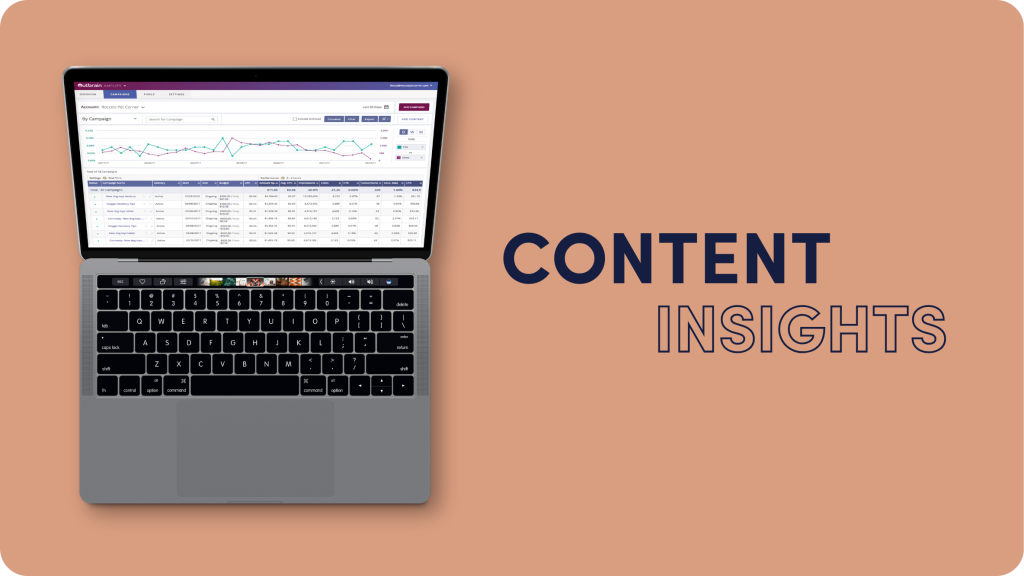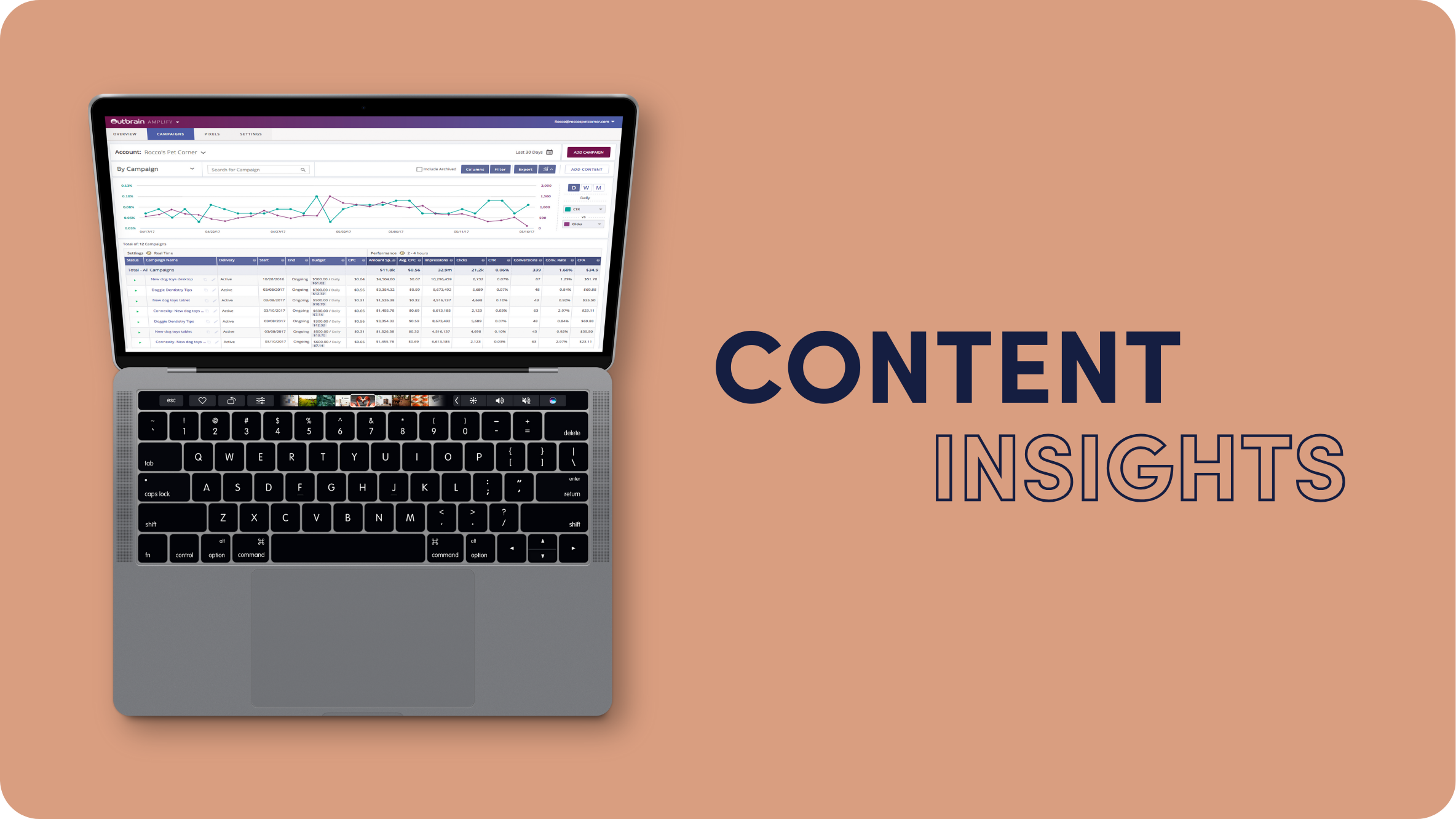Content Marketing Analytics: Measure, Analyze, Optimize for Content Performance

According to the Content Marketing Institute, 84% of marketers report that content marketing helped them achieve their brand awareness goals in the past year and 58% say that content marketing helped them build sales and revenue.
No doubt nailing your content marketing brings major benefits. That said, for many content marketers, wading into the analytics and gaining insightful conclusions may seem daunting. Data can be difficult to parse, especially when it relates to the more creative aspects of content production and marketing.
The goal of great content is to drive engagement, build brand awareness, and demonstrate authority. But how can you tell if it’s working? Even better, how can you use data to make sure your content delivers maximum value to your business?
By understanding and leveraging content analytics.
Understanding Content Marketing Analytics
Content marketing analytics is the process of collecting data about the performance of digital content, interpreting that data, and using it to improve your content marketing efforts. There is a wide range of metrics used in content marketing analytics to measure content performance on various channels. Content market analytics is a pulse check, a window into how well your content resonates with your target audience and drives them toward specific objectives.
It’s important to lean on content marketing analytics because they’re the only way to tell if your content strategy is helping you achieve your objectives. They’re the best way to diagnose issues at certain points in the content funnel, allowing you to make targeted adjustments. For this practice to work, the first thing a marketer must do is define:
- Their target audience;
- Their core objectives;
- The KPIs they’ll use to measure the performance of the content piece or campaign.
From page views and organic traffic to engagement and conversion rates, there are numerous ways to confirm whether your content is landing.
The Key Metrics for Content Performance
At Outbrain, there are seven groups of content performance metrics we use to measure the efficacy of our content. For the benefit of your content campaign, we’re breaking them down below, starting with…
1. Traffic metrics
How many people are visiting your website, blog, or landing page? Traffic metrics will tell you. You can find out how many unique visitors have read your content, if they returned, and how long they spent on the content page before moving on.
These metrics are powerful because they indicate the audience’s interest in your content over time. If traffic drops, then something is wrong with the content. If a particular blog is getting a lot of traffic, then clearly it is popular and engaging. Combined analysis of traffic metrics will help you diagnose your content performance even further. For example, a high number of page views is a great thing, but if the bounce rate is also high, then that tells you page visitors are not finding what they’re looking for after clicking.
Traffic metrics to tap into content marketing performance:
- Unique Visitors: The number of distinct individuals who visit your content.
- Pageviews: Total number of pages viewed by visitors.
- Sessions: A period of continuous activity on your website by a visitor.
- Bounce Rate: Percentage of visitors who navigate away from the site after viewing only one page.
2. Engagement metrics
Content marketing analytics track and measure content performance, but what you are really analyzing is customer behaviors. When people engage with content, it means they are reading or watching it, sharing it online, commenting on it, or interacting with it in some way. All this indicates how effective a piece of content is. And that’s what engagement metrics are all about.
How long do users stay on a given webpage? Did they find the information relevant enough to comment on or share it? How far did they scroll through your blog post, and at what point did they convert or bounce? Engagement metrics help you answer questions like these, and get a better understanding of which content resonates best with specific audiences.
Engagement metrics to learn about your audience:
- Time on Page: Average time visitors spend on each page.
- Scroll Depth: How far visitors scroll down a page.
- Social Shares: Number of times your content is shared on social media platforms.
- Comments: The level of interaction and engagement through comments on your content.
3. Conversion metrics
The purpose of all marketing, including content marketing, is to convert audiences to customers. The more efficiently you can ‘nurture’ leads to the bottom of the marketing funnel, the better your content strategy is performing.
That’s why, as content marketers, we also need to hone in on the metrics at the base of the funnel: conversion metrics. These measure how many audience members are reaching major milestones in your funnel. Looking at all of these metrics together can also help you form a picture of how healthy your content marketing funnel is.
For example, if you’re generating a ton of leads through your content marketing, but most of them are drying up by the time it’s time to sign on the dotted line, that’s a sign there’s an issue between click and conversion.
Conversion metrics to tweak your approach:
- Lead Generation: Number of leads generated through content, such as sign-ups, downloads, or inquiries.
- Conversion Rate: Percentage of visitors who complete a desired action (e.g., making a purchase or signing up for a newsletter).
- Sales: Direct revenue generated from content marketing efforts.
- Customer Acquisition Cost (CAC): The cost associated with acquiring a new customer through content marketing efforts.
4. SEO metrics
Customers use search engines (mostly Google) as their first port of call for almost everything. If your company appears organically at the top of the page for a search term they’re interested in, that builds immediate trust and authority that can’t be bought.
SEO metrics are the language of search engines, giving content marketers direct insights into how well their content is ranking for search queries on the web. SEO is partly based on a well-defined keyword strategy, as you can measure how well your content stands up to your competitors for certain keywords (both paid and search). The name of the game? Visibility.
For example, the team at Outbrain demonstrated how well SEO ties into brand awareness in 2022. We published a blog post about the Best World Cup Marketing Campaigns a few weeks before the big game. The post rocketed to the top of the SERP for several search keywords, including ‘World Cup marketing’ and ‘World Cup campaigns 2022’.
Usually, SEO is a long game. It can take months for a post to build traction, but this one blew competitors out of the water in just two weeks. Not only did this increase our brand awareness, but it also emphasized the importance of bringing an SEO mindset to every piece of online content you release.
SEO Metrics to pay attention to:
- Keyword Rankings: Your content’s position in search engine results for targeted keywords.
- Organic Traffic: Traffic generated through search engine results.
- Backlinks: Number of external websites linking to your content, indicating its authority and relevance.
5. Brand awareness metrics
Brand awareness metrics measure how well your target audience knows your brand, whether they have positive, negative, or neutral associations with it. If your brand has high awareness among the target audience, this is a good sign that your content marketing (among other things) is doing its job.
One metric in particular is gaining ground at the moment: attention. Third-party cookie depreciation is set to make audience tracking and targeting more challenging. Attention metrics offer an alternative solution for digital marketers to know whether their ads or content are getting the true attention of their audience, and if it is making a real impact.
For example, Liebherr Home Appliances wanted to build awareness among their target audience about a new product release. To do so, they worked with the Outbrain team to create a series of four video ads that highlighted the best features of their latest release, and let the data roll in.
Across all four ads, they saw 20% higher attention from audience members when compared to the industry’s video benchmark. This success not only confirms interest in this latest product but can also drive future campaigns forward.
Brand awareness metrics vital to your strategy:
- Brand Mentions: Instances where your brand is mentioned online, indicating visibility.
- Brand Sentiment: The overall sentiment (positive, negative, neutral) associated with your brand online.
- Brand Lift: Changes in brand perception or awareness as a result of content marketing efforts
- Attention Score: A new IAB-recognized metric the measures how engaged or focused a user is on an ad.
6. Retention and loyalty metrics
Once you’ve secured a conversion, the story doesn’t end there. It is vital to maintain a close connection with existing customers to make sure they stay as customers. This is what retention marketing aims to do. Retention and loyalty metrics for content marketing campaigns help you understand your customer’s experience with your brand and how well your content is serving them, or – in some cases – when it no longer does.
For example, a beauty brand launches a retention campaign, sending an email newsletter to existing customers with a discount offer for their next purchase. By analyzing retention and loyalty metrics, it is possible to uncover whether the campaign was successful in engaging customers and encouraging them to make a repeat purchase.
Customer loyalty is the lifeblood of any business. While a healthy incoming pipeline is essential, creating content and products that your current customers want to keep coming back to is the gold standard. By paying attention to retention, you can keep your finger on the pulse of your customer base, ensuring you continue to serve them while bringing in new customers.
Retention and loyalty metrics that tell your customer story:
- Return Visitors: Percentage of visitors who return to your site.
- Churn Rate: The rate at which customers stop engaging with your content or unsubscribe.
- Customer Lifetime Value (CLV): The total revenue a customer is expected to generate throughout their relationship with your brand.
7. Cost metrics
At the core of every content strategy is a key goal: good ROI. Cost-driven metrics compare the amount of money you’re investing in your content strategy to the value said strategy is providing.
The key is to use several cost metrics to check on your ROI, rather than relying on the broad strokes. Granular metrics like CPA, CPL, and CPC are an insight into your campaign’s health at different stages of your customer’s journey. For example, if your cost per click is fairly low but your cost per acquisition is too high to justify, this indicates that your content might be interesting to click on, but lacks the substance needed to convert your ideal audience.
Cost metrics to measure return on investment:
- Cost per Acquisition (CPA): Cost associated with acquiring a new customer through a piece of content or a content marketing campaign.
- Cost per Lead (CPL): Cost associated with generating a new lead through content marketing efforts.
- Cost per Click (CPC): Cost associated with each click on your content.
How to Use Content Marketing Analytics to Boost Your Campaign Results
Content marketing analytics help you understand how to improve your content so it achieves its goal. The data-driven approach takes away the confusion around content, providing concrete metrics that shed light on what works for your audience, and what doesn’t.
Once you know which metrics to keep an eye on, the most important thing is to be proactive! Use the data to find what’s not working, diagnose the issue, and create a plan to boost your content performance.
Let’s dive a little deeper into some key strategies that will define your content’s success.
Iterative content optimization
Content marketing is an ongoing process. Create the content, promote it to the target audience, track and measure its performance, explore the content marketing analytics to gain insights, and then refine and optimize your strategy accordingly. Rinse and repeat, over and over again.
The key is to embrace iteration. The goal is not necessarily to produce perfect content every single time; the goal is to listen to what your content marketing analytics are telling you and use that vital information to improve incrementally.
Your next step: Create a content monitoring strategy that incorporates the metrics covered above. Capture how your audience is responding to your content. From there, you can use it to deliver the content they’re looking for.
Personalized content experiences
Embracing content marketing analytics as a discipline gives you a unique edge. Let’s face it, there’s a lot of content out there, and that means plenty of competition. But it’s not about creating content that everyone wants to read, it’s about honing in on what your audience wants.
Leveraging analytics-based insights allows you to become more niche with your content, tailoring it to meet your audience’s unique preferences rather than trying to be broadly appealing. This is the fire in your content strategy, and the thing that will make you stand out above the crowd.
Your next step: Define your audience with as much granularity as possible, enabling you to target your content to a tee and measure how well it resonates with your specific audience.
Audience insights
Content marketing analytics don’t just provide insights about your content. They give you a window into your customers’ minds, what they are interested in, and what makes them tick, enabling you to refine your buyer personas and improve your marketing strategy as a whole.
What content are they engaging with? Which videos do they watch over and over again? Which blog posts kick them into a sale, and which ones kick them off the site?
Your next step: Use the analytics data you already have to identify which messages resonate most with your audience. What do they care about, what converts them, and what repels them?
Case In Point: Content Marketing Campaign by Spotify
So, how does this all look in practice? Let’s lean on one of the industry’s most successful brands to look deeper into how great content marketing can drive your audience to you in droves.
Enter: Spotify.
This audio-streaming giant is far from resting on its laurels, constantly looking for new and better ways to cater to their audience. This is a company defined by content, and every marketing choice they make is backed by audience data.
Take, for example, the 2023 Wrapped season. For the uninitiated, Spotify Wrapped is an interactive experience Spotify subscribers can access at the end of every year. It summarizes their listening habits and compares them to others in similar circles. It was a stroke of genius by a single intern that has now evolved into one of the biggest pop culture events of the year, allowing Spotify subscribers to post, share, and compare music tastes with their circle.

Source: Spotify
On top of that, they noticed a trend sparked by every year’s Wrapped release: friends asking each other, “What’s on your Wrapped?”. So the development team decided to take advantage of the audience’s natural interest and create interactive billboard experiences and other out-of-home advertising to promote Wrapped on a wider scale.
They also jumped over to YouTube, bringing the spotlight on the year’s top global artist: Taylor Swift. This video has netted over 450,000 views to date, making it one of the top-performing videos on Spotify’s YouTube channel.
Over on social media, the name of the game was hashtags. #Spotifywrapped2023 generated over 30,000 posts on Instagram alone, inviting both artists and listeners to celebrate the year that was. With so much engagement, it drove subscribers into Spotify’s arms in record numbers.

The data speaks for itself. In 2017 – the year after the inception of Wrapped – 30 million users accessed the feature. In 2022, that number had already jumped to over 156 million users. It was truly the ‘realest’ year of Wrapped that the company has ever seen, and with the level of engagement they enjoyed, there’s plenty of data to make the next season even better.
Let Data Drive Your Content Upward
This is the power of content marketing analytics. By engaging with what your audience truly wants and using metrics to make data-backed decisions, you can measure success in more than just a feeling.
Create the content your audience wants to see, and reap the benefits. It won’t happen overnight, but if you persist – and with the help of content marketing analytics to guide you – the results will come.



